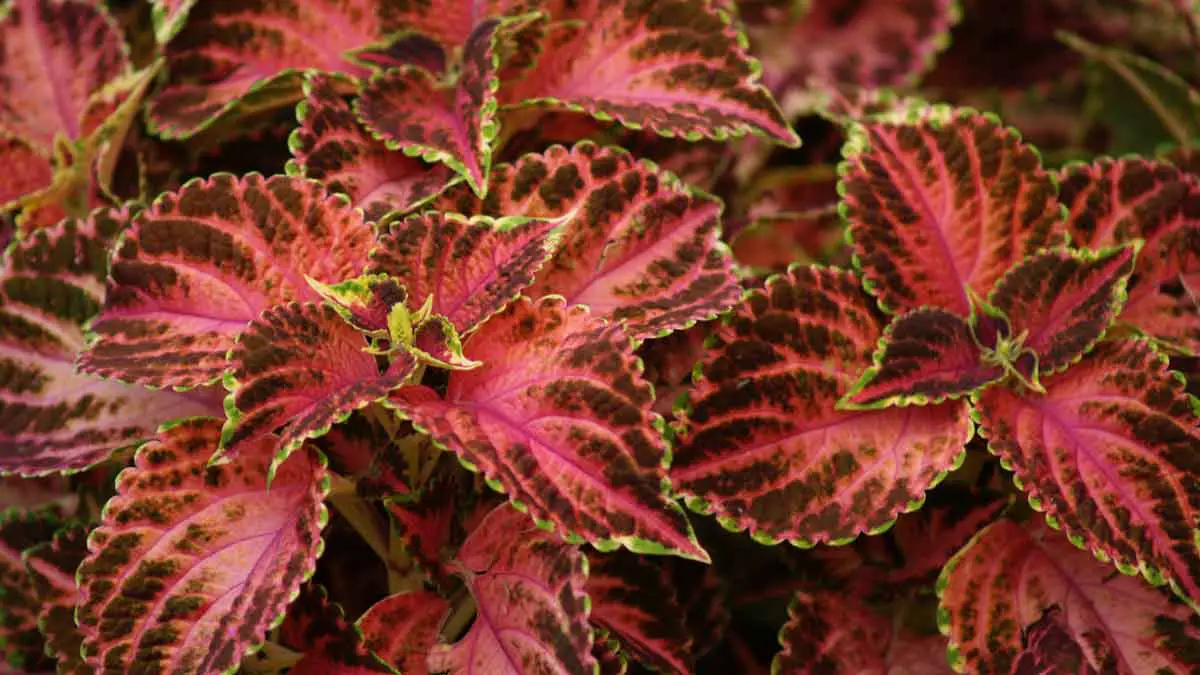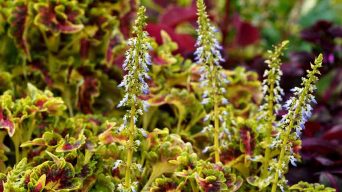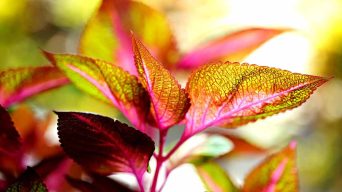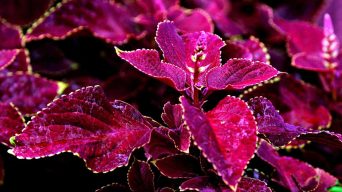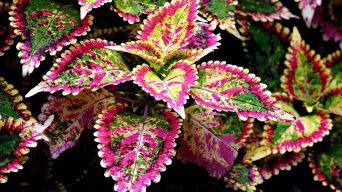Coleus plants are known for their vividly colored leaves, which can add a splash of brightness to any garden. They’re generally easy to care for, but occasionally you may run into problems, like leaves falling off.
There are a few reasons your coleus plant’s leaves might fall off.
It could be due to stress from too much sun or not enough water.
Another possibility is that the plant is infested with pests, such as aphids or mealybugs. Or, it could be a disease, such as powdery mildew or leaf spot.
In this article, we’ll discuss the various reasons why coleus leaves fall off and how to fix the problem.
What Causes Coleus To Drop Leaves
If you find your coleus leaves falling off, you first need to figure out what’s causing the problem.
Here are some common reasons:
1. Overwatering
One of the most common reasons for coleus leaves to drop is overwatering.
When coleus are overwatered, they can’t take up enough oxygen and nutrients, which can cause the leaves to turn yellow and fall off.
Overwatering is often caused by watering the plant too often or using too much water.
To avoid overwatering, only water your coleus plant when the soil is dry to the touch.
2. Underwatering
While overwatering can cause coleus leaves to fall off, so can underwatering.
When plants don’t get enough water, the leaves will droop and eventually fall off.
To avoid underwatering, water your coleus plant regularly, especially during hot weather.
3. Too Much Sunlight
Coleus plants prefer partial shade, so the leaves can start to fade and fall off if they’re getting too much direct sunlight.
When coleus leaves are exposed to too much sunlight, they can also become sunburned, which will cause the leaves to turn brown or black and fall off.
If you think your coleus plant is getting too much sun, move it to a shadier spot.
4. Not Enough Light
While coleus plants prefer partial shade, they do need some sunlight to thrive.
Light is essential for the plant to produce food through photosynthesis.
If your coleus plant is not getting enough light, the leaves will start to turn pale and eventually fall off.
To ensure your coleus plant gets enough light, place it in an area where it will get at least 4 hours of sunlight per day.
5. Extreme Temperatures
Coleus plants are sensitive to both extreme heat and cold.
If the temperature gets too high or too low, the coleus leaves can turn brown and fall off.
To protect your coleus plant from extreme temperatures, place it in an area where the temperature will stay between 60-80 degrees Fahrenheit.
6. Soil Issues
The soil in which your coleus plant is growing can also cause the leaves to fall off.
Coleus plants prefer rich, well-drained potting mix.
If the potting soil is too sandy or too clay-like, it can cause the plant to become stressed, and the leaves will start to fall off.
To fix this problem, mix some organic matter, such as compost, into the soil to improve drainage.
7. Root Rot
Root rot is a fungal disease that can affect coleus plants.
It’s caused by too much moisture in the soil, which can happen if the plant is overwatered or if the soil doesn’t drain well.
Root rot will cause the coleus leaves to turn yellow and fall off.
To prevent root rot, make sure only to water your coleus plant when the soil is dry and improve drainage by adding organic matter to the soil.
8. Fungal Diseases
Several fungal diseases, such as powdery mildew, downy mildew, and leaf spot, can affect coleus plants.
These diseases are caused by fungi that live in the soil and attack the plant when conditions are wet.
Fungal diseases cause the leaves to turn brown or black and fall off.
To prevent these diseases, ensure to water your coleus plant at the base of the plant rather than wetting the leaves.
You should also avoid watering the plant in the evening, so the leaves have time to dry before nightfall.
9. Pest Infestation
Pests, such as aphids, mealybugs, and whiteflies, can also cause coleus leaves to fall off.
These pests suck the sap from the plant, which can weaken it and cause the leaves to drop.
To get rid of pests, use a pesticide or some natural remedies, such as neem oil or insecticidal soap.
10. Nutrient Deficiency
If your coleus plant is not getting enough of certain nutrients, it can cause the leaves to fall off.
The most common nutrient deficiency that affects coleus plants is a lack of nitrogen.
Nitrogen is essential for plant growth; the leaves will turn yellow and fall off if the plant does not get enough of it.
You can add nitrogen to the soil using fertilizer or compost.
11. Chemical Damage
If you use chemicals, such as herbicides or insecticides, on your coleus plant, it can cause the leaves to fall off.
These chemicals can damage the plant and make it more susceptible to pests and diseases.
To avoid this problem, only use chemicals on your coleus plant if necessary, and always follow the instructions on the label.
12. Transplant Shock
When you transplant a coleus plant, it can go into shock, which can cause the leaves to fall off.
Transplant shock is caused by the stress of being moved and can weaken the plant.
To avoid transplant shock, choose a spot for your coleus plant that has similar lighting and soil conditions as the place it was growing before.
You should let the plant rest for a few days after transplanting it before watering it or applying any fertilizer.
13. Using the Wrong Pot
If you’re using the wrong type of pot for your coleus plant, it can cause the leaves to fall off.
Coleus plants prefer to grow in pots made of a porous material, such as clay or terracotta.
Pots made of plastic or metal can prevent the soil from draining properly, which can cause the plant to become waterlogged and the leaves to start to fall off.
To fix this problem, transplant your coleus plant into a pot made of a porous material.
14. Natural Leaf Drop
In the fall, coleus plants will go through natural leaf drop.
During this time, the plant will start to shed its leaves in preparation for winter.
Natural leaf drop is normal, and there’s no need to worry unless the plant is shedding more leaves than usual.
If you want to keep your coleus plant looking its best, you can trim off the dead leaves as they fall.
What To Do If Your Coleus Leaves Are Falling Off
When coleus leaves start falling off, it’s a cause for concern. This is especially true if the leaves are healthy and green one day and then brown and withered the next.
If you’re dealing with a coleus plant that’s shedding its leaves, here are a few tips on what you can do:
1. Check The Soil
The first thing you should do is check the soil. If the soil is dry, water the plant and see if that helps. If the soil is wet, try to improve the drainage by adding some sand or gravel.
Coleus plants need well-drained soil to thrive, so ensure the pot has drainage holes in the bottom.
2. Prune The Coleus Plant
If the coleus plant is leggy or too big, it can cause the leaves to fall off. To fix this problem, prune the plant to encourage new growth.
Start by cutting off any dead or dying leaves. Then, cut back the stems to the desired length.
You can also remove any branches that are crossing over each other or rubbing against each other.
3. Water The Coleus Plant Properly
If you’re overwatering or underwatering the coleus plant, it can cause the leaves to fall off.
To water the plant properly, stick your finger in the soil and see if it’s moist or dry. If the soil is dry, water the plant.
If the soil is wet, wait a few days before watering again.
4. Provide The Coleus Plant With The Right Amount Of Light
Coleus plants need a lot of light to grow, but too much light can cause the leaves to fall off.
If you live in an area with strong sunlight, try placing the coleus plant in a spot with partial sun.
You can also try using a sheer curtain to filter the light.
Coleus plants that don’t get enough light will start to stretch, and the leaves will fall off.
To fix this problem, move the plant to a spot that gets more light.
5. Keep The Coleus Plant in the Right Temperature Range
Coleus plants prefer to grow in warm temperatures but can’t tolerate extreme heat or cold.
If the temperature is too high or too low, it can cause the leaves to fall off.
To keep the plant in the proper temperature range, place it in an area between 60°F and 80°F.
In the winter, you can move the coleus plant indoors to protect it from the cold.
You can move the plant to a spot with afternoon shade in the hot summer months.
6. Protect The Coleus Plant From Pests
Pests can cause coleus plants to shed their leaves. Common pests that attack coleus plants include aphids, whiteflies, and mealybugs.
To get rid of pests, you can use an insecticidal soap or neem oil. You can also try using a homemade pest control solution with water and dish soap.
It’s also a good idea to keep an eye out for pests and remove them by hand if you see any.
7. Fertilize The Coleus Plant
If the coleus plant is not getting enough nutrients, it can cause the leaves to fall off.
To fertilize the plant, use a water-soluble fertilizer with a ratio of 20-20-20. Fertilize the coleus plant once a month during the growing season.
8. Avoid Using Chemicals
Chemicals can damage coleus plants and cause the leaves to fall off. To avoid this problem, only use organic products on your plant.
If you must use a chemical product, test it on a small area of the plant first.
9. Check for Diseases
Certain diseases can cause coleus plants to shed their leaves. Common diseases that affect coleus plants include leaf spot, powdery mildew, and root rot.
If you think your plant is infected, you need to remove the affected leaves and stems. You can also try using a fungicide to get rid of the disease.
It’s essential to quarantine any infected plants to prevent the disease from spreading.
10. Check for Physical Damage
If the coleus plant is damaged, it can cause the leaves to fall off. Common causes of damage include wind, rain, and hail.
You need to remove any damaged leaves or stems to fix this problem. You can also try using a plant growth hormone to encourage new growth.
What Are The Benefits of Coleus Leaves Falling Off?
It may seem counterintuitive, but there are several benefits to coleus leaves falling off.
For one, it allows the plant to redirect its energy from producing leaves to other growth areas, such as the roots or flowers.
Additionally, shedding old leaves helps the plant eliminate any pests or diseases that may be present.
Finally, the coleus plant can absorb more light by shedding its leaves and improving its overall health.
Leaves falling off naturally also allows the coleus plant to produce more vibrant and colorful new leaves.
So, don’t be alarmed if you see your coleus plant shedding its leaves! It’s a good thing.
However, some cases where coleus leaves falling off are not normal and can indicate a problem.
If the leaves are falling off in large quantities or if they are turning brown or black before falling, this could be a sign of a disease or pest infestation.
Additionally, if the leaves are falling off and the plant looks overall unhealthy, it could be a sign of poor drainage or too much sun exposure.
If you notice any of these problems, take action immediately to correct the issue.
What To Do With Coleus Leaves That Fall Off
There are several uses for coleus leaves that fall off.
For one, they can be used as mulch. Spread the leaves around the base of the plant to help retain moisture and prevent weeds from growing.
Additionally, coleus leaves make a great addition to compost. They help improve drainage and aeration while also providing nutrients to the compost.
Coleus leaves can also be used in crafts or as decorations. Use them to make coasters, placemats, or even jewelry.
Finally, coleus leaves can be used to grow new coleus plants. This is a great way to propagate coleus plants or to create new plants for your garden.
So, don’t throw away those coleus leaves that fall off! There are many uses for them.
How to Grow Coleus Plants from Leaves?
The process is quite simple if you want to grow coleus plants from leaves.
Just follow these steps:
- Take a coleus leaf cutting from a healthy plant. Make sure the cutting has at least two sets of leaves.
- Dip the cutting in a rooting hormone. This will help encourage root growth.
- Plant the cutting in a pot filled with well-draining soil. Water the soil until it is moist but not soggy.
- Place the pot in a warm, sunny location.
- Keep the soil moist and wait for the cutting to take root. This can take anywhere from 2-4 weeks.
Once the cutting has taken root, you can transplant it into your garden or keep it in the pot.
You can also root the cutting in water. Just place the cutting in a jar of water and change the water every few days.
After a few weeks, the cutting will develop roots and can be transplanted into soil.
With proper care, your coleus plant should thrive and produce new growth.
Final Thoughts
Coleus plants are a beautiful and easy-to-care-for addition to any garden.
However, sometimes coleus leaves falling off is normal and can benefit the plant.
Other times, it can be indicative of a problem.
If you notice your coleus leaves falling off, take a closer look at the plant. If the leaves are falling off in large quantities or if the plant looks unhealthy, take action to correct the problem.
Otherwise, enjoy your coleus plant and make use of the fallen leaves!

